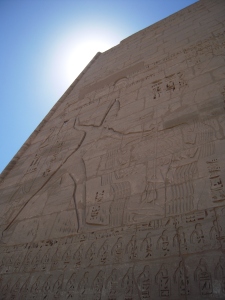
Tribute to the Sands of Egypt
Kate Simpson

The enigmatic Great Sphinx sits on Egypt's Giza Plateau.
Dear Friends,
The tale of the Egyptian Prince Tutmosis III and his encounter with the Sphinx of Giza fascinates me. On a hunting trip in the Valley of the Gazelles some time before his reign, Tutmosis III decided to take a nap to escape the midday sun. He chose the shade below the head (the only visible section) of the Great Sphinx of Giza.
While he slept, the Sphinx spoke to him and told him that, if he dug the Sphinx out of the sand that covered it, he would be assured the throne of Egypt. So Tutmosis III set to work and excavated the Sphinx, the very first restoration of this site, undertaken circa 1400 B.C.E. The story of this dream is recounted on the stelae at the Sphinx’s feet. What captivates me about this tale is the fact that, even in 1400 B.C.E., the Sphinx and the Pyramids of Giza were already ancient, having existed since 2650 B.C.E., and that the protective layers of desert sand had already buried all but the Sphinx’s head over the preceding 1,200 years.Egypt’s ancient wonders abound, but it is not until you stand within inches of the deeply carved cartouches of Ramses II in Karnak or the stunning turquoise of painted vulture wings on Hatshepsut’s Temple, or the intricate delicacy of King Tutankhamen’s jewelry, that the impossibility overwhelms you. How can such beauty have survived 2,000, 3,000, 4,000 years?

Vivid colors of a vulture's plumage on Hatshepsut's temple
Entering the imposing structure of Ramses III Temple, there is a series of chapels to the left. Little color remains, and the carvings seem simplified, unremarkable. It turns out, these chapels date to Alexander the Great’s time—circa 332 B.C.E. Modern, by Egyptian standards! Yet paling in comparison to the elaborate scenes of battle and power depicted on Ramses III’s own temple walls.
Deep in the Temple of Luxor (circa 1400 B.C.E.), past the small area that once served as a chapel for Roman soldiers during the 3rd century C.E., there is a shrine built by Alexander the Great, depicting the Greek king as a pharaoh. Here, you can stand between the outer wall built by Amenhotep III and the inner wall of the Greek shrine. Within a couple of feet of each other, the contrast is sharp: over a 1,000 years pass from the time the Egyptian outer wall was carved to the time the Greeks erect their shrine. Yet, Alexander the Great’s craftsmen lose this contest: their work appears amateurish at best.

Image of Ramses III on his temple
It’s not often that Alexander the Great comes across as lacking accomplishment. Yet ancient Egypt puts many more modern cultures to shame. Even the Romans, who seemed to lack the respect and interest Alexander showed Egyptian culture, appear boorish and uncultured in comparison. The Roman chapel within the Temple of Luxor is made of scavenged temple stones, betrayed by the upside down body parts and images carved on their surfaces.
Reflecting on all the perfection that bears tribute to Egypt’s royal ancestors, I can’t help but wonder what we have lost over time in sophistication, technique, and ambition. And I rejoice in the protective benefits of the sands of Egypt—without them, what treasures would have been lost to humankind!
For information on our educational journeys to Egypt, click here.

/https://tf-cmsv2-journeys-media.s3.amazonaws.com/journeys/catalog/cover_image/Mar_24_SJ_Cover.jpg)
 Be the First to Know
Be the First to Know